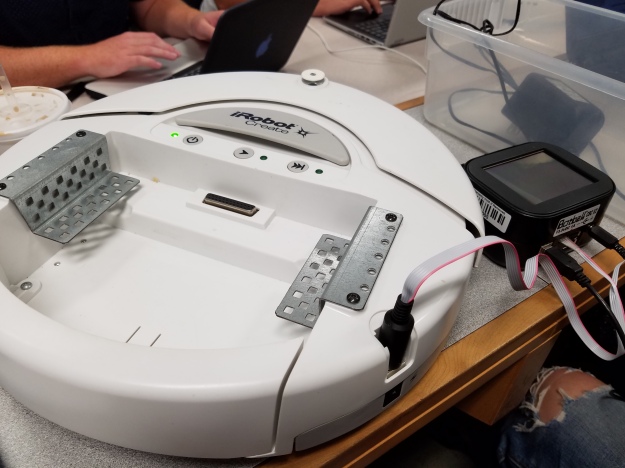Hello again, my dear reader.
Today is the day me and my friends and fellow peers Urooj Haider and Emmanuel Braxton tackle our first small Robotics assignment. It is a Lab which will get us acquainted with the basics of programming a Robot through KISS (KIPR’s Instructional Software System) and running a simulation through it as well.
Currently, Urooj is writing for her own blog while Emmanuel goes and grabs a circular Robot made compatible with the programming application. I am downloading the application on my Ubuntu operating system (dual loaded with Windows 10 which was the original system on the computer.) while also getting Wine (a program used to help Ubuntu run Windows programs) set up as well.
Braxton got back now, so we are putting the bot together. Once it is together we will then begin to program some basic instructions for the bot to follow, and we hope that it will work smoothly and quickly. Oh! And I forgot to mention; Braxton ran the sim of the robot in the program and it had crossed a white line (I’m assuming representing a wall) and showed that its bumpers could tell when it had hit something.
So, we just now completed setting up the robot. Here is an image that I took using my Galaxy S7 Edge phone:

The device connects via a circular cable, which goes into the Botball device. Both the bot and the device itself can be charged via a much smaller in diameter circular power cord. Along with the ability to connect to each other and to connect to a power source for charging, it also has a usb cable that, from the Botball device, connects the bot all the way to Braxtons laptop.
So, we just ran the program through the Botball connected to the bot itself. The Botball store the program for immediate use simply by clicking a run button to begin running the code. Connected to the bot, it feeds it the instructions we gave it: Move forward for approx. ten seconds and then wait ten seconds, after which it would shut down (the program.) It was incredibly fascinating to see it come to life in the push of a button!
Right now, I’m watching on as Urooj and Braxton talk between each other as Braxton begins programming for use with the bot. There are methods we can use for the robot which can do the following things (and more): Move forward or backward, rotate on the spot clockwise or counter-clockwise, pause to wait, pause awaiting user input, etc.
With complex enough coding, one could make up games to play with the bot! One game I imagine is in which the robot rotates constantly and you have to try and guess where it will land. It randomly calculates how long it will rotate for and whoever gets the closest guess, wins!
What is Braxton programming, you may ask? Well, he’s attempting to program in a way for the robot to check and give the distance it traveled over the time it was used. There is a specific method for getting and setting travel time.
We are working through some of the kinks of working with C programming. It for sure is not completely straightforward nor easy to diagnose when issues occur, but it is completely doable. We are attempting to get it to move a distance, tell when its moved a certain amount, and then stop it from moving past that amount of distance.
I have completed my version of the programming which worked out flawlessly in the simulation, and now we are also trying out Braxtons code too. His code worked and only went over by 35mm.
Now both of our code is nearly perfected, but I gotta run out due to out of school plans.
hope you enjoyed my post!
Sending good vibes,
Sean M. Raleigh; CS Major at WSU
From the blog CS@Worcester – Sean Raleigh's CS Blog by sraleigh62 and used with permission of the author. All other rights reserved by the author.

